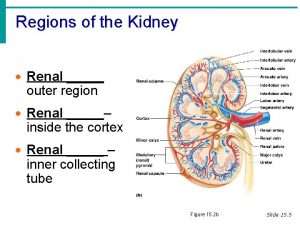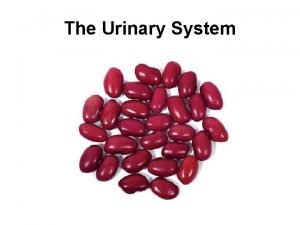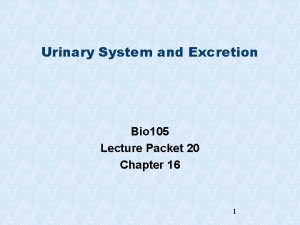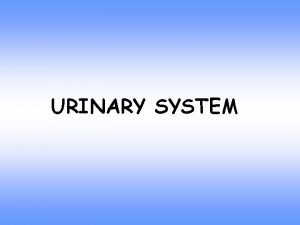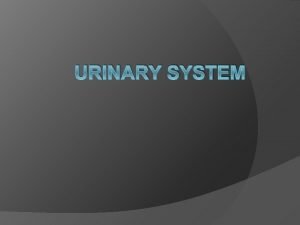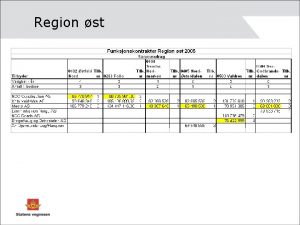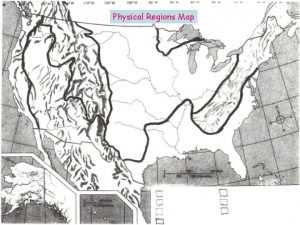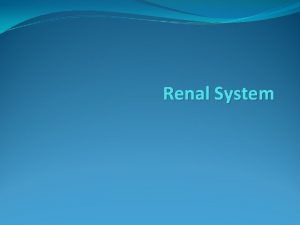Regions of the Kidney Renal outer region Renal












- Slides: 12

Regions of the Kidney · Renal _____ outer region · Renal _____– inside the cortex · Renal _____ – inner collecting tube Figure 15. 2 b Slide 15. 5

Kidney Structures · _______– triangular regions of tissue in the medulla · ______– extensions of cortex-like material inward · _____ – cup-shaped structures that funnel urine towards the renal pelvis Slide 15. 6

Nephrons · The ________of the kidneys · Responsible forming ______ · Main structures of the nephrons Slide 15. 8

Glomerulus · A specialized ______bed · Attached to arterioles on both sides (maintains ________) · Large afferent arteriole · Narrow efferent arteriole Figure 15. 3 c Slide 15. 9 a

Glomerulus · Capillaries are covered with podocytes from the renal tubule · The glomerulus sits within a ________(the first part of the renal tubule) Figure 15. 3 c Slide 15. 9 b

Renal Tubule · _____ (Bowman’s) capsule · _____con voluted tubule · ______ · ____conv oluted tubule Figure 15. 3 b Slide 15. 10

Types of Nephrons · _____ nephrons · Located entirely in the cortex · Includes _____nephrons Figure 15. 3 a Slide 15. 11 a

Types of Nephrons · J_______nephrons · Found at the ______ of the cortex and medulla Figure 15. 3 a Slide 15. 11 b

Characteristics of Urine Used for Medical Diagnosis · Colored somewhat yellow due to the pigment urochrome (from the destruction of hemoglobin) and solutes · Sterile · Slightly aromatic · Normal p. H of around 6 · Specific gravity of 1. 001 to 1. 035 Slide 15. 19

Facts about Kidney filtration & reabsorption • The two kidneys are only 0. 4% of the body weight but receive about 25% of the blood. • Their most important function in the body is to regulate the composition and volume of body fluids. Blood flows in and out of kidney leaving behind the 1% which becomes urine. The urine produced flows through ureters to the bladder and through urethra to outside world • The typical kidneys filter approximately 180 liters of plasma/day and each • of the 3 • • liters of plasma gets filtered about 60 times. To replace this much water you would have to drink a 12 ounce soft drink every 3 minutes of the day fortunately 99% of the filtrate gets reabsorbed, leaving 1. 5 -2 liters of urine per day. This is an incredible amount of filtration that is performed every day. We have a total of 2 million nephrons in the 2 kidneys when we are young

• To give you an idea of the quantity of reabsorption across the nephron, let's look at the sodium ion (Na) as an example: • Proximal tubule - reabsorbs 65 percent of filtered Na. In addition, the proximal tubule passively reabsorbs about 2/3 of water and most other substances. • Loop of Henle - reabsorbs 25 percent of filtered Na. • Distal tubule - reabsorbs 8 percent of filtered Na. • Collecting duct - reabsorbs the remaining 2 percent only if the hormone aldosterone is present.

STOP HERE
 Renal tubule
Renal tubule Sindrome nefrótica
Sindrome nefrótica Res extra commercium
Res extra commercium Detrusal
Detrusal Interpolar region of kidney
Interpolar region of kidney What are the three regions of the kidney
What are the three regions of the kidney Vasa recta vs peritubular capillaries
Vasa recta vs peritubular capillaries Cortical region of kidney
Cortical region of kidney Voting districts definition ap human geography
Voting districts definition ap human geography Jim crow laws in what region or regions did it exist
Jim crow laws in what region or regions did it exist Infraspinatus insertion and origin
Infraspinatus insertion and origin Active region and saturation region
Active region and saturation region đặc điểm cơ thể của người tối cổ
đặc điểm cơ thể của người tối cổ
